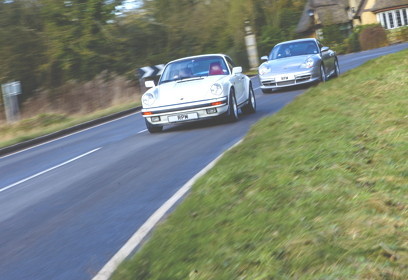Twin test: 3.2 Carrera v Gen2 996
It’s a surprising fact that even today, you still hear people say “I can’t afford a 911.” Despite this myth, the good news is that actually, yes you can. The 911 has been in continuous production for almost half a century, so offers a quite unrivalled selection of second-hand possibilities from which we have chosen accessible examples of what might loosely be termed the old and the new.
The 3.2 is often referred to as the last traditional 911, a direct evolution of the original Sixties Porsche that was distinctly old fashioned by the time of its 1983 launch. It stayed in production until 1989, by which time Porsche had launched the visually similar 964.
Later in 1997, Porsche abandoned the air-cooled engine to move to a water-cooled one. A second decision, also born of economic and environmental necessity, was to design a new chassis that would be the basis of not only the new 911, but the new entry-level Porsche.
For many buyers new to Porsche 911s, the 996 is the starting point. Our test car is a 2002 ‘facelift’ model, which had the new 3.6 engine offering 20bhp more than the first 3.4 water-cooled block. Criticised upon launch for its bland appearance, the smooth profile of the 996 has aged well, and the purity of its lines, like the original 911, has regained favour. Our sample car has a GT3 nose and side skirts that enhance the positive impression. For the 996, Porsche completely redesigned the cabin. Again, this was viewed unfavourably by some, who argued that a £70,000 car deserved a more distinguished cockpit. A decade later, the Porsche neophyte spending our notional £15,000 would have less to complain about. Sure, the 996’s insides didn’t wear as well as earlier 911s, but they respond to careful use, and our ten-year-old example is immaculate.
To younger generations, the 3.2 might come as a shock: the whaletail is a distinguishing period feature, as are the ‘impact bumpers’, but otherwise the traditional 911 looks remarkably compact compared with modern metal. The cockpit will appeal instantly to people brought up with MGBs or TR6s, but to drivers in their 20s or 30s, the inside of the 3.2 can seem almost primitive. This is not to say a traditional 911 was ever austere. With leather seats, fully carpeted with upholstered door panels, an electric sunroof and central remote locking, the Eighties Porsche was a £38,000 luxury model. Look closely and you’ll notice the quality of the fittings, from the solid-looking indicator stalks and quality of the air vents, which are different from the rather flimsy items on the 996. The box for magnetic tape cassettes is a pleasing period fitting, but the disc holder on the ten-year-old 996 is already a throwback to a largely defunct technology.
Like the 996, the 3.2 offers an exemplary driving position, even if the slightly offset steering wheel and floor hinged pedals take some adjusting to. The solid five-instrument fascia has become an automotive icon, lasting 34 years until the arrival of the all-new 996. In terms of equipment, don’t expect ABS (not compatible with the torsion bar suspension) or power steering (at this price Porsche was taking a risk by not offering it – PAS would not appear until the 964). US specification included air conditioning, otherwise heating is regulated by a combination of dash-controlled fans and a switch beside the handbrake which allows warm air to flow from the heat exchangers. Very effective, if fiddly when working, the various mechanisms can seize up due to age or lack of use.
With our drive underway…
*You can read the full feature of our entry-level 911 twin test complete with stunning photographs in issue 98 of Total 911. For back issues, simply visit: https://www.imagineshop.co.uk/magazines/total911/total-911-issue-98.html
Or you can make sure you never miss an issue of the world’s only magazine dedicated to the Porsche 911 by subscribing: http://www.imaginesubs.co.uk/subscribe-to-total-911





Comments (0)